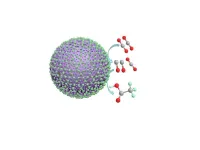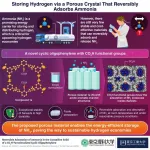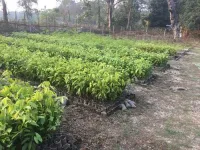(Press-News.org) Acetic acid, also known as acetate, and other products that can be developed from acetic acid are used in a variety of industries, from food production to medicine to agriculture. Currently, acetate production uses a significant amount of energy and results in harmful waste products. The efficient and sustainable production of acetate is an important target for researchers interested in improving industrial sustainability.
A paper published in Carbon Future on July 9 outlines a method using a polyaniline catalyst with cobalt oxide nanoparticles to produce acetate through carbon dioxide electroreduction.
“The polyaniline catalyst with cobalt oxide nanoparticles has two components—polyaniline as a continuous material and cobalt oxide as nanoparticles dispersed on the polyaniline. This cooperative structure makes a highly selective catalyst that can produce acetate during carbon dioxide electroreduction. Cobalt oxide is in charge to produce carbon monoxide intermediate and then pass them to polyaniline, where acetate is formed by electroreduction,” said Liwen Wang, a professor at the School of Chemistry and Chemical Engineering at Nanjing University in Nanjing, China.
Polyaniline is a conducting polymer that has been proven to be a highly selective catalyst used in the generation of other carbon products. This study looks at the role of polyaniline and the mechanism of carbon dioxide electroreduction over the polyaniline surface. A higher carbon monoxide concentration on the polyaniline enhances carbon to carbon coupling on the catalyst surface. Adding cobalt oxide nanoparticles as a supplementary catalyst creates a tandem reaction that is highly selective for acetate.
“This configuration facilitates a higher local carbon monoxide concentration over polyaniline and enhances carbon-to-carbon coupling. The non-metallic polyaniline material can provide excellent performance in electrocatalysts,” said Wang. She went on to describe the synergy between the polyaniline material and the cobalt oxide nanoparticles. “The polyaniline provides available active sites for increasing the carbon-to-carbon coupling, while the cobalt oxide nanoparticles offer a large number of carbon monoxide intermediates.”
To measure how well the polyaniline/cobalt oxide catalyst worked, researchers also prepared two control samples: a polyaniline catalyst without cobalt oxide and a cobalt oxide catalyst. The polyaniline/cobalt oxide catalyst had improved crystallization with a larger crystal size and uniform deposits of the cobalt oxide nanoparticles. The polyaniline coating also meant there was a higher surface area, which most likely meant there were more sites for the electro-conversion of carbon dioxide. A test called an electron pragmatic resonance (EPR) measurement showed that the polyaniline/cobalt oxide catalyst had more oxygen vacancies, which trap the carbon dioxide and allow the proton-electron transfers necessary for the transformation.
Additional testing went on to confirm that it was not the cobalt oxide or the polyaniline alone that accounted for the improved performance of the polyaniline/cobalt oxide catalyst. It was the synergistic nature of the polyaniline and cobalt oxide together.
Looking ahead, researchers hope to continue improving the synergistic performance between polyaniline and cobalt oxide on this catalyst. “The next step is to optimize the catalyst system, enhancing the tandem effect for better performance. The ultimate goal is the direct electrosynthesis of acetate using carbon dioxide and water as raw materials,” said Wang.
Other contributors include Pengfei Liu and Qiang Wang of Nanjing Tech University in Nanjing, China; and Jie Yang, Chenjia Liang, Changshun Deng, Yinxuan Zhao, Xuefeng Guo, Luming Peng, Nianhua Xue, and Weiping Ding of Nanjing University in Nanjing, China.
The National Science Foundation of China and the Ministry of Science and Technology of China supported this research.
About Carbon Future
Carbon Future is an open access, peer-reviewed and international interdisciplinary journal, published by Tsinghua University Press and exclusively available via SciOpen. Carbon Future reports carbon-related materials and processes, including catalysis, energy conversion and storage, as well as low carbon emission process and engineering. Carbon Future will publish Research Articles, Reviews, Minireviews, Highlights, Perspectives, and News and Views from all aspects concerned with carbon. Carbon Future will publish articles that focus on, but not limited to, the following areas: carbon-related or -derived materials, carbon-related catalysis and fundamentals, low carbon-related energy conversion and storage, low carbon emission chemical processes.
About SciOpen
SciOpen is an open access resource of scientific and technical content published by Tsinghua University Press and its publishing partners. SciOpen provides end-to-end services across manuscript submission, peer review, content hosting, analytics, identity management, and expert advice to ensure each journal’s development. By digitalizing the publishing process, SciOpen widens the reach, deepens the impact, and accelerates the exchange of ideas.
END
Insilico Medicine (“Insilico”), a clinical-stage generative artificial intelligence (AI)-driven drug discovery company, today hosts Insilico Medicine Generative AI Action (IMGAIA) webinar. The webinar featured opening remarks by Alex Zhavoronkov, PhD, Founder and CEO of Insilico Medicine. During the virtual event, Alex Aliper, PhD, co-founder and president of Insilico Medicine, announced the company’s sustainability initiative. Following this, the session on product launches and updates was delivered by key AI project ...
KINGSTON, R.I. – July 22, 2024 – A team of researchers at the University of Rhode Island and Nova Southeastern University in Florida have been tracking a 26-foot endangered whale shark – named “Rio Lady” – with a satellite transmitter for more than four years – a record for whale sharks and one of the longest tracking endeavors for any species of shark.
Whale sharks, which live from 80 to 130 years, are the world’s largest fish and third largest creature in the ocean – behind blue and fin whales. The size of a small school bus, they inhabit tropical oceans and ...
(WASHINGTON, July 24, 2024) – In patients with diffuse large B-cell non-Hodgkin lymphoma (DLBCL), the two hallmark post-chimeric antigen receptor (CAR)-T therapy toxicities are extremely rare after two weeks, supporting a shorter, more flexible toxicity monitoring period, according to a study published in Blood Advances.
Currently, three CAR T-cell therapies — axicabtagene ciloleucel (axi-cel), tisagenlecleucel (tisa-cel), and lisocabtagene maraleucel (liso-cel) — are approved for treating DLBCL, a cancer that affects the white blood cells responsible for producing antibodies. However, patients receiving these therapies are ...
Information like forest canopy height can be useful in assessing the health of a forest, but current measuring methods are not always feasible for large geographic regions or adaptable to diverse forest types. Monitoring from space can be a solution.
Forests function as more than a place for a quiet retreat: trees intake and absorb carbon dioxide (a major greenhouse gas), a process also known as carbon sequestration, and are essential parts of water regulation, habitat provision, and support much of the world’s terrestrial biodiversity. Quantifying forest structure parameters, ...
All around the world, scientists are striving towards next-generation energy technologies that can help us move away from fossil fuels. Using hydrogen as an energy carrier and clean energy source is perhaps one of the most promising solutions on the horizon. However, there is a major challenge to overcome before hydrogen economies become a reality: hydrogen gas is remarkably difficult to store and transport safely, which severely limits its applicability across many fields.
Against this backdrop, a research team from Tokyo Institute of Technology, Japan, and Tokyo University of Science, Japan has been working hard to reach an alternative solution to the hydrogen storage problem. Led by Associate ...
Exercise is one of the best ways to reduce your risk of heart disease or having a second cardiovascular event, such as a heart attack or stroke.
As more people use wearable technology, such as smartwatches, health care researchers continue to explore whether it can successfully promote physical activity.
That includes customized messages designed to encourage individual patients to be more active in their current location, like walking outside when the weather is nice.
In such a study led by the University of Michigan ...
DALLAS, July 24, 2024 — In this era of machine learning and artificial intelligence, harnessing large-scale neuroimaging can facilitate new discoveries in neuroscience research.[1]
To that end, the American Heart Association, celebrating 100 years of lifesaving service in 2024, has awarded a two-year, $460,000 grant to a consortium of three academic medical centers to work collaboratively and share de-identified imaging data from individuals enrolled in its Get With The Guidelines® – Stroke registry.
A team at Yale University will ...
Glenview, Illinois – The American College of Chest Physicians® (CHEST) recently released a new clinical guideline on central airway obstruction (CAO). Published in the journal CHEST®, the guideline contains 12 evidence-based recommendations to guide the management of both malignant and nonmalignant CAO.
“Central airway obstruction is associated with a poor prognosis, and the management of CAO is highly variable dependent on the provider expertise and local resources. By releasing this guideline, the panel hopes to standardize the definition ...
PULLMAN, Wash. – Marriage equality appears to have a major economic benefit for countries. Washington State University researchers found that European countries that recognized same-sex marriages kept more of their highly skilled workers from emigrating to the U.S.
The researchers analyzed 20 years of data on HB1 visas, which are reserved for immigrants to the U.S. with advanced degrees and specialized skills. From 2000-2019, a total of 13 European Union countries legalized same-sex marriage—and ...
DURHAM, NC – Reforestation in low- and middle-income countries can remove up to 10 times more carbon dioxide from the atmosphere at lower cost than previously estimated, making this a potentially more important option to fight climate change, according to a study in Nature Climate Change.
Reforestation regrows trees on degraded lands where human activities removed original forests. Most current reforestation programs focus on tree planting alone, but the study estimates that nearly half of all suitable reforestation locations would be more effective at sequestering carbon if forests were allowed to grow back ...




